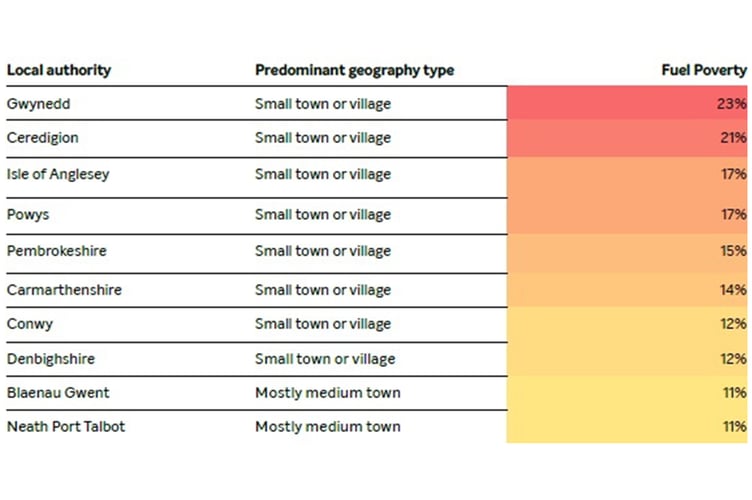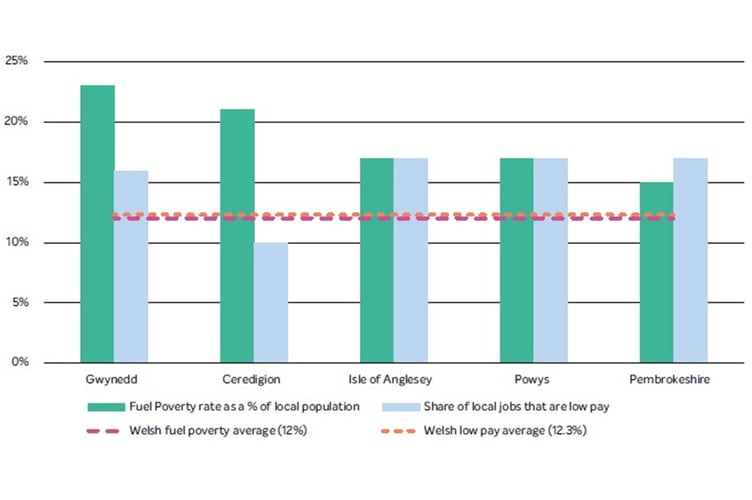Ceredigion and Gwynedd have among the highest rates of fuel poverty and child poverty in Wales, a fresh report into the ongoing cost-of-living crisis has revealed, as calls are made for more targeted local funding in a bid to tackle the issue that has seen “living standards squeezed beyond any level seen for generations”.
New research by economics think-tank the Centre for Progressive Policy (CPP) outlines the impacts the cost of living crisis is having in different places in Wales, with figures showing stark warnings for the mid and north of the county.
The report shows that people and families on low incomes are being increasingly impacted by rising food prices, mortgage and rent hikes, and spiralling energy bills as the crisis continues.
Figures outlined in the report show that 30 per cent of Ceredigion children are living in poverty – the highest in Wales – with Gwynedd at 28.20 per cent.
Gwynedd has the highest fuel poverty rate in Wales, with 23 per cent struggling with rising costs.
In Ceredigion, 21 per cent – the second highest in Wales – are living in fuel poverty.

Powys has the highest number of residents on low pay at 17 per cent, with Gwynedd also high up on the list at 16 per cent.
Ceredigion is the only county in the country that features high in the child and fuel poverty categories in spite of having a low pay percentage lower than the national average.
While a lack of data means it is difficult to determine the true extent to which the cost of living crisis has impacted households in Wales, research published throughout the crisis has pointed to the Welsh experience of the crisis being one of the most severe.
Mind, the mental health charity, found that the majority (53 per cent) of people in Wales have seen their mental health worsen due to the financial impacts of the cost of living crisis.
Public Health Wales has recently highlighted the vast drop off in the number of people in Wales claiming they were ‘not at all’ worried about their finances from 60 per cent in January 2022 to just 27 per cent in January 2023.

A study by Loughborough University earlier this year also found Ceredigion had one of the highest rates of child poverty in Wales, with one in four youngsters throughout mid and north Wales affected.
That data estimated that 3,678 children in Ceredigion were living in poverty in 2021/22, with 6,563 children in Gwynedd and 6,897 in Powys.
The Loughborough report warned that the poverty numbers are likely to spike as the latest data “does not cover the period during which the cost-of-living crisis really took hold, nor the period of extremely high and rising inflation that has been particularly prominent in relation to the costs of food and fuel.”
A report last December but before Ceredigion County Council found that the number of households living in poverty in Ceredigion has increased by 9 per cent between 2018 and 2022.
The CPP report – which also looked at the other UK devolved nations to get a picture of the crisis outside of England – said that “relative to other parts of the UK, the crisis seems to be more acute within Wales.”
A survey conducted around the end of 2022 by the University of Bristol’s Personal Finance Research Centre found that more than one in five households (22 per cent) in Wales were facing ‘serious financial difficulty’ as a result of the cost of living crisis, which is higher than both Scotland and Northern Ireland, as well as all of the English regions.
“Rural and remote places, including small town and village communities in Wales are more vulnerable to high inflation due to high levels of fuel poverty combined with other local factors, such as higher food prices and lower rates of pay,” the CPP report found.
food parcels were handed out in Ceredigion in the year to March, according to figures provided by the Trussell Trust
food parcels were handed out in Gwynedd in the year to March, according to figures provided by the Trussell Trust
The report calls for more money to be put into the hands of local authorities to tackle issues at a more local level.
“Where devolved governments have offered financial support to local authorities, this has generally been done to provide council tax relief, rather than to provide flexible funding to tackle challenges which conventional household support mechanisms may not be able to reach,” the report found.
“For instance, in 2022 the Welsh Government introduced a £152m package of measures to help local authorities deliver support to their communities, but just 16 per cent (£25m) of this was discretionary funding for councils to allocate themselves, while the remainder was for council tax relief.”
The report also calls for better data collection, with concerns that the true number and extent is not known due to the paucity of available statistics.
A lack of data can mean that any intervention and support is missed or delayed.
The report adds: “Our analysis underlines a strong case to improve the conditions in which local leaders and their partners are working to tackle the cost of living crisis, and to increase their ability to target resources to the challenges faced in their areas.”
Ceredigion, Gwynedd and Powys councils have all set up pages on their websites detailing all the available to help for residents as the crisis continues.
Department for Work and Pensions figures show around 8,300 households in Ceredigion and 14,200 in Gwynedd were eligible for the cost-of-living payment scheme, the first instalments of which were made earlier this year.
With inflation is beginning to fail, the rate still stands at almost eight per cent, pushing prices and mortgage rates up while wages remain stagnant.

The CPP report adds: “While energy prices are forecast to begin falling, with the Energy Price Cap that sets consumer energy prices in Great Britain has fallen to £2,073 in July, it would be unwise to see this as the beginning of our return to normality and a pathway to improving living standards across the board.
“£2,073 is nearly double where the Energy Price Cap was in the autumn of 2021.
“On top of this, food price inflation remains very high at 18.4 per cent, while housing insecurity continues to deepen and widen as continued high inflation in rental costs shows little sign of abating.
“In the last 18 months, living standards have been squeezed beyond any level seen for generations, as rising living costs have brought the consequences of over a decade of economic stagnation to fruition.”
Ross Mudie, research analyst at CPP and report author, said: “Rising living costs are adding pressure to virtually all households in Wales, but our analysis reveals significantly different pressures in different parts of the country.
“Renters, particularly those on low incomes, are being squeezed by high rents and a lack of available properties for those claiming housing benefit.
“For those in small towns and villages, it is high rates of fuel poverty and low paid jobs that leave people vulnerable to the impact of rising prices – although a lack of available data makes it difficult to pinpoint these pressures in more detail.
“Local authorities know their communities best, so the Welsh government must provide more flexibility in how funding can be used to target the support that is most needed.
“It must also urgently update local area poverty statistics, so that local and national policy can better understand and respond to the situation on the ground.”



.jpeg?width=209&height=140&crop=209:145,smart&quality=75)

Comments
This article has no comments yet. Be the first to leave a comment.